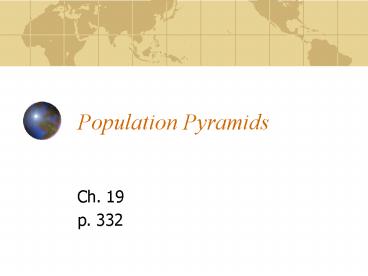Population Pyramids - PowerPoint PPT Presentation
1 / 25
Title: Population Pyramids
1
Population Pyramids
- Ch. 19
- p. 332
2
Define Population Pyramid p. 331-336
- Graphs that show the structure of a population by
age gender
3
Expanding 1
- Low life expectancy HEIGHT of pyramid!
- High death rates pyramid is narrow along the
sides, especially the middle top. - High birth rates BASE of pyramid is wide).why?
- Generally a lower standard of living!
- In todays world UNDERDEVELOPED countries.
4
Expanding How do you know?
- BASE is WIDER than the middle section
- In other words the YOUNG (lt15 yrs) outnumber
those in the FERTILITY GROUP (15-39 yrs)
5
Expanding 2
- Higher life expectancy why? (height getter
higher) - High death rate (Narrow tip of pyramid)
- High Birth Rate(wide base of pyramid)
- Developing nationbecause of access to health
care!! - Getting wider higher!!!)
6
Stable or Stationary
- Higher life expectancy (again getting taller).
- Death rate are also declining (Sides are
widening!). - Birth Rate are declining (bottom of the pyramid
narrowing or shrinking)!!! - Developed countries womens roles, career,
education family choices, etc.!!
7
Stationary How do you know?
- BASE the middle section are almost EQUAL
- In other words the YOUNG (lt15 yrs) is
approximately the SAME as those in the FERTILITY
GROUP (15-39 yrs)
8
Contracting (shrinking)
- Higher life expectancy (height of pyramid is
high.) - Death rate are also declining (top widening even
more). - Birth Rate very low (bottom shrinking/narrowing)..
.why? - Consists of a GRAYING POPULATION (more older
people than youngerhealth care, lifestyle
choices etc.) - Developed countries such as Canada, US, Sweden
etc.
9
Contracting How do you know?
- BASE is MORE NARROW than the middle section
- In other words the YOUNG (lt15 yrs) much lower
than the FERTILITY GROUP (15-39 yrs)
10
Another quick look
11
PRACTICE
- Classify each as expanding, stationary or
contracting. - Which would have the lowest standard of living?
Why? - Which would have the highest standard of living?
Why? - Which would resemble Canada? Iceland?
Afghanistan?
12
The answers !!
- Stationary
- Iceland
- Expanding
- Afghanistan
- Lowest Standard of Living
- Contracting
- Canada
- Highest Standard of Living
13
Derive population characteristics from a
population pyramid.
- Width of the base birth rate (wide vs. narrow)
- Height indicates life expectancy
- Symmetry compares males females (left side vs.
right side) - Type determined by comparing the Middle Vs
Base (Expanding, Stationary or Contracting?)
14
Derive population characteristics from a
population pyramid.
- Shape of sides indicate death rate (concave vs.
convex, wide vs. narrow) - Bumps in the sides indicate demographic
anomaly...irregularities, events (indentations
vs. protrusions) - Classification indicates standard of living
level of development etc. (different types)
15
Compare population pyramid shape standard of
living.
- Generally speaking stable/contracting populations
are characteristic of a high standard of living
due to - Low birth rate due to good family planning,
access and affordability of birth control,
financial career planning, education, etc. - Low death rate due to good medical care,
nutrition, education, sanitation etc., etc.. - Generally speaking an expanding population is
characteristic of a lower standard of living. - High birth rate due to poor access and expense
of birth control, lack of education etc. - High death rate due to poor medical care,
education nutrition, lack of sanitation etc.,
etc..
16
Dependency Ratio
- What does dependant mean?
- Who are the dependants in society?
- Dependency Ratio The ratio of dependant people
to working people. - Dependants include
- (0-14 years old) AND
- (65 years old)
- Working People include
- (15-64 years old )
- The formula is
- DR (pop. 0-14) (pop. 65) X
100 (pop. 15-64) - The dependency ratio (DR) of a population
indicates how many people are dependant upon
every 100 workers.
17
Dependency ratios
- The dependency ratio (DR) of a population
indicates how many people are dependant upon
every 100 workers. - The formula is
- DR (pop. 0-14) (pop. 65) X
100 (pop. 15-64)
18
Sample Questions
19
Sample Questions
20
Sample Questions
21
Canada
22
CHAD
23
CHINA
24
Which is El Salvador?Which is Finland?
25
Go to http//www.census.gov/ipc/www/idbpyr.html
and create your own population pyramids































